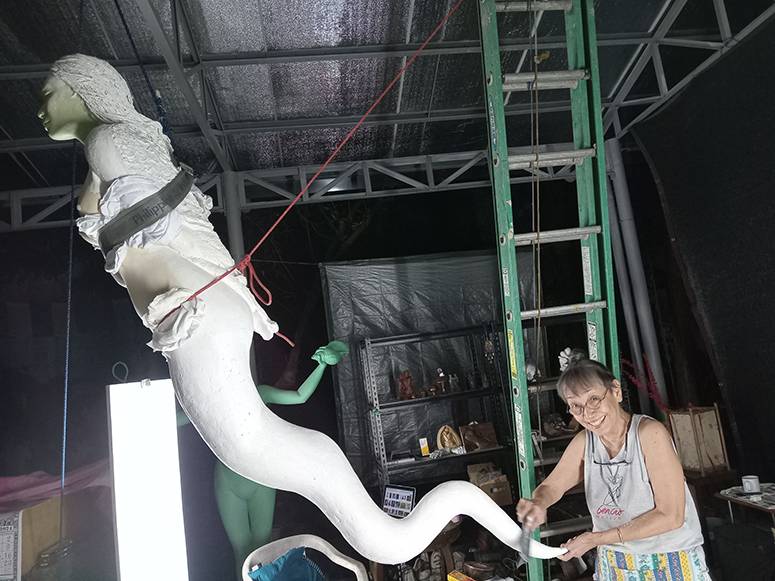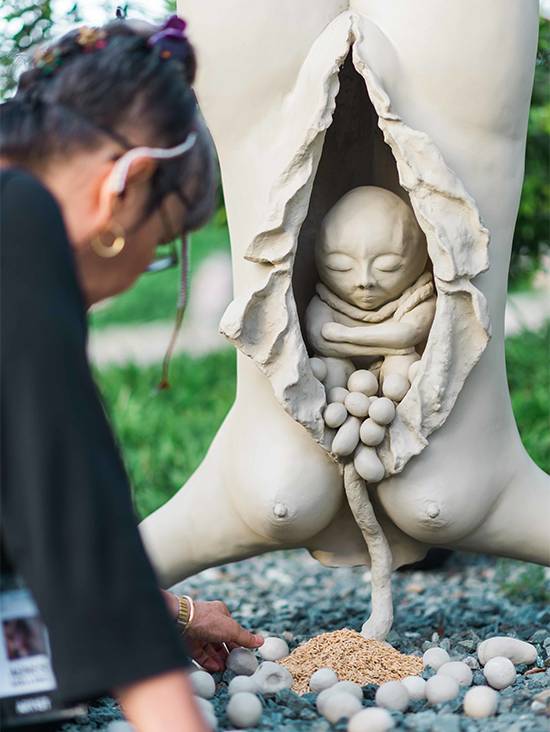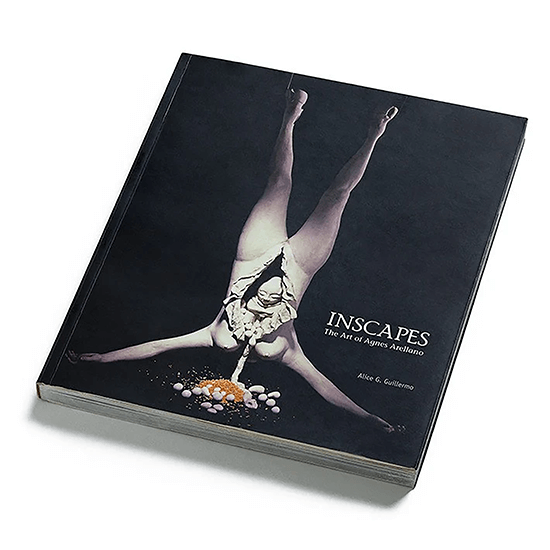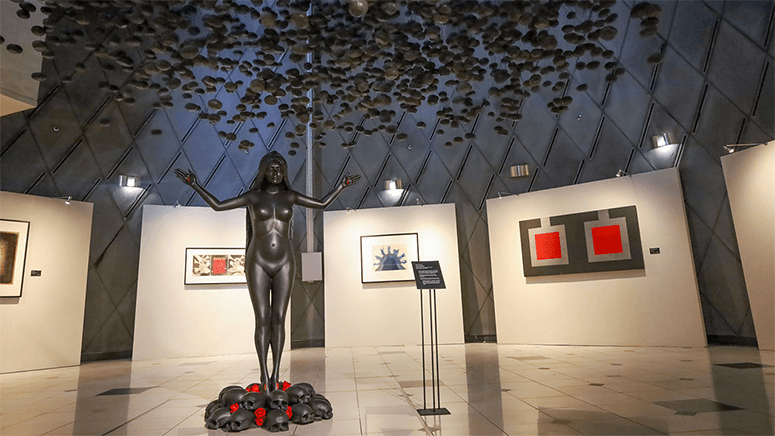Agnes Arellano: From erotic reliefs to sacred groves
For her significant contribution in Visual Arts: Sculpture, Agnes Arellano will be conferred an Ateneo College Award in the Arts for Outstanding Achievement in the Humanities on Thursday, June 13. The School of Humanities’ recent dean, Jonathan Chua, announced the ceremony will be held at 5 p.m. at the PLDT-Convergent Technologies Center.
I’m elated for my “younger sis,” who’s been one of my dearest, longest friends, dating back to the early1960s. The distinction comes at a time when she’s in prime creative mode, with her impressive gigs overlapping one another.
Just recently, responding to publisher and bookshop propietor Katrina Santiago’s request, Agnes designed the Sisa Prize trophy for young women writers who were awarded at Everything’s Fine bookshop, where her Bliss: Khajuraho Sketches, a series of erotological reliefs, was on reprise exhibit.

Ongoing at Pinto Art Museum in Antipolo is a blockbuster show mounted in cooperation with the Mexican embassy: Buenviaje: Manila-Acapulco-Manila. The works are dedicated to the miraculous Black Virgin of Peace and Good Voyage now housed in the Antipolo cathedral, as well as different aspects of the 250-year galleon trade when products were exchanged between the sister-cities of the Spanish empire.
Arellano’s sculpture, titled Study for the Figurehead of the Galleon Angel de la Guardia aka Magwayen, depicts a half-naked sea serpent goddess named Magwayen from the Visayan myth. Made in coldcast bronze, it’s mounted on a shipwrecked mulawin plank and accented with abaca rope, based on an actual galleon made in Pasacao, Camarines Norte.
Last year, Agnes was among some 20 artists who were commissioned to do sculptures that were immersed in a one-hectare flat area 60 meters under the sea, designated by marine biologists as the Pinto Underwater Sculpture Museum for Marine Biosystems Regeneration. Her marine-concrete version of the verdigris Pleiad Inanna with the conch shell in her hand was the last to be submerged from the naval vessel Waray, escorted by frogmen from the Coast Guard and divers from the Navy, into the waters of Currimao Bay, Ilocos Norte. This environmental project of Dr. Joven Cuanang received enthusiastic support from local government.

As far as her relations with Ateneo de Manila University are concerned, in 2019 she had a retrospective at the Ateneo Arete’s Ignacio Jimenez Amphitheatre for outdoor installations. This involved all of her lifesize, livecast nudes, and temple pieces in gleaming white coldcast marble. Basically, her partner Billy Bonnevie curated the inventory from their dungeon storage.
Beginning with birth, out came the pregnant moon goddess Haliya, her first work in 1983—with some intact pieces like the flute music from her temple, activated by a sensor if the viewer came near enough. In the center stood the gate guarded by the Angel of Death from the sun god temple, flanked by multi-breasted Dea and new mother Vesta from the inscape Tatlong Buddhang Ina. These same pieces had been exhibited in New York.

Inscapes: The Art of Agnes Arellano
Ending with death was the hooved headless Carcass-Cornucopia and her music composed by skull notes. Agnes still recalls how wonderful it was to observe the students laying out mats to watch from the amphitheater’s grass seats, then lingering on to read and study. But what stays strongest in her memory was the collateral ekphrastic exercise.
“After I gave a walkthrough to the students of Carlomar Daoana’s creative writing and poetry workshops, they came up with astounding verses, which they read one full-moon night on the Arete lawn while Pinikpikan played varied percussion instruments.”
Leading the readers were esteemed poets Marne Kilates and Mookie Katigbak-Lacuesta. With the Ateneo Art Gallery’s generous support under the care of Boots Herrera, a fold-out publication was distributed with each of the poems alongside images of the work that inspired them, designed by one of the student poets.
“Then there was the lockdown! Everything was frozen in time at the Arete until the pandemic was over.”
In 2022, the quaternity of sisters from the Pleiades project had a solo gig in Pinto Art Museum and Arboretum, joined by two floor pieces drawn from past inscapes. Born in 2017 as tea-stained and golden-hued at Art Fair PH, they were seen a year later alighting at the UP Diliman campus, all verdigris-green amidst the trees in a sacred grove. At Pinto they were polychromed: verdigris Inanna, blue Kali, black Magdalene, and symbolizing Fire, vermilion for Flying Dakini who was suspended from the ceiling.

Presently, Black Magdalene—lifesize, livecast polychromed cast stone—is on display till the end of June at the Yuchengco Museum, where curator Con Cabrera initiated Woman: Thesis and Antithesis, a major exhibition of works by women artists in the CCP collection of Thirteen Artist Awards recipients.
This same quaternity will be joining the Bangkok Art Biennale 2024 which opens in October this year, curated by Apinan Poshyananda, who also curated the Three Buddha Mothers in the Asia Society exhibit in New York. The four figures were chosen for their relevance to the theme for BAB2024: Nurture Gaia. Agnes says she’s so thrilled to be exhibiting alongside her long-idolized favorites Louise Bourgeois, Marina Abramoviç, and Joseph Beuys.
“At the moment,” Agnes adds, “our studio is busy with the refurbishment of our artist’s copy of Carcass-Cornucopia/Music for Making the Sun Rise, a two-piece inscape from 1987 which will soon be shipped to Seoul for the September show Talking Bodies-Asian Women Artists, a group show of 60 women tackling the idea of transcorporeality.”



